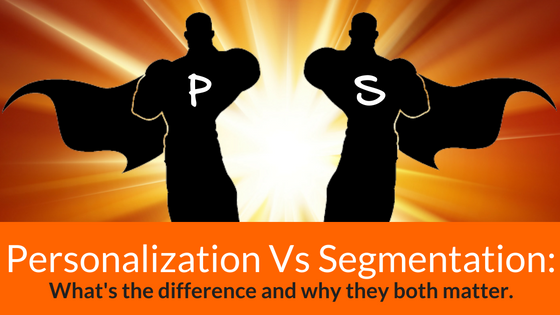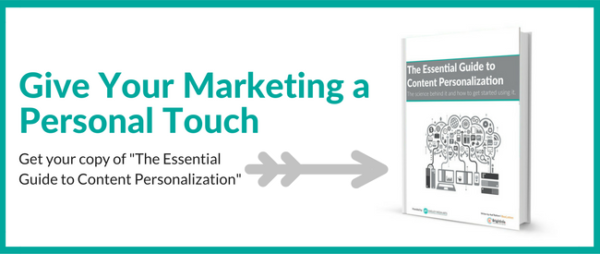Today’s consumer is flooded with more marketing messages than any one person can handle. As a result, we’ve have become very good at ignoring unwanted attempts to gain our attention. The reason so many of the marketing messages we are presented with each day feel so impersonal is because they are. In attempts to be “relevant” or “trendy”, many marketers try to reach too broad a segment of the market and, as a result, fade into the ever-increasing noise. To stand out and entice users to engage, marketers are turning to better segmentation and personalization to help them reach their intended niche more effectively. But what’s the difference between personalization and segmentation and why are they so important?
Personalization and segmentation on the surface appear to be very similar, but in actuality, they are very different. Many times people get confused with these two and end up linking them together. Both segmentation and personalization are extremely important for marketers to grasp and execute. But lumping them together, as if they were the same thing, prevents them from being effective.
What is Segmentation:
Segmentation is a marketing strategy which involves breaking down a broad target market into smaller groups of consumers, businesses, or countries that have, or are perceived to have, common needs, interests, and priorities. The goal of segmentation is to get a better idea of how a group of like-minded people act and interact. From this information, a marketer can them design and implement a strategy to target them.
There are a number of ways in which a marketer can segment an audience. Some of the most common ways are:
- Demographic: Break down according to sex, age, race, generation, occupation, etc.
- Geographic: Break down by geographic regions such as county, state, city, neighborhood.
- Behavioral: Break down by knowledge of, attitude towards, usage rate, response.
- Cultural: Break down by cultural origin.
- Psychographic: Break down by the activities, interests, and opinions (AIOs) of customers.
Why Segmentation is Important:
In order to effectively communicate your message, segmentation is critical. The type of segmentation used will depend on the overall goal of the marketing strategy. For instance, if you are going to send coupons for your suntan lotion company, you are going to want to be sure that you send them to homes near locations that have beaches. So a geographic segmentation is a great place to start.
The more you segment, the more targeted your audience becomes. Within each of your segments, you can break them down further by using, “hyper-segmentation.” Let’s say you break down your segment by demographics and you are targeting middle-class mothers with children under the age of 5. Now, on the surface this appears to be a good segment, but if you wanted to go deeper and target better you could break that group of middle-class mothers with children under the age of 5 into smaller segments based on behaviors or psychographics This would allow you to deliver a more contextually appropriate empathetic message that would deliver truer results. The more segmented, the more powerful your message can be.
What is Personalization:
Personalized marketing, also know as one-to-one marketing or individual marketing, is a strategy based on leveraging data analysis and digital technology to deliver individualized messages and product offerings to current or prospective customers. While segmentation addresses a group of people with common traits, personalization is focused on the single user. Advancements in technology and data collection have given the marketer tools to deliver their message in a more human way. But personalization isn’t all about technology.
While technology is used to collect the data and help the marketer deliver their personalized message, personalization starts with a better understanding of the people a marketer is trying to reach. Just because you collect data and can deliver a customized engagement, doesn’t mean it’s going to attract the user to engage. If personalization is going to be truly effective, a detailed persona that outlines the demographics, geographics, behavioral tendencies, cultural influences and psychographics must be done. Personalization is about creating a more human connection using the tools we have available. The only way you can achieve that is if you actually understand your audience.
Why Personalization is important:
We live in a culture that is constantly being bombarded with messages. As a result, we are losing our ability to pay attention. Gen Z, who are now in their freshman year of college, can boast of an 8-second attention span. This generation is now the largest generational group in the U.S., having overtaken the millennials in what Sparks & Honey describes as a coming “demographic tsunami.” As this group continues to mature, hammering them with more and more information is going to do very little in persuading them to choose one brand over another.
No matter your generation, one thing speaks to the heart of people unlike anything else, being treated as an individual. I have said it before and will stand by it here, all of us are emotional creatures and, at our core, we are seeking two things; significance and security. In other words, we want to be known and appreciated for who we are and we want to feel safe. This can only happen through one-on-one connections. As a marketer myself, my job is to help create these connections, authentically, with the tools available. For companies looking to grow now, personalization is the way to go.
The Impact of Personalization
- Personalized emails deliver six times higher transaction rates, but 70% of brands fail to use them.
- Sixty percent of marketers struggle to personalize content in real-time, yet 77% believe real-time personalization is crucial.
- Nearly three-fourths (74%) of online consumers get frustrated with websites when content (e.g., offers, ads, promotions) appears that has nothing to do with their interests.
- In-house marketers who are personalizing their web experiences and who are able to quantify the improvement see, on average, a 19% uplift in sales.
Source: http://www.cmo.com/features/articles/2015/2/18/mind-blowing-stats-personalization.html
While personalization isn’t technically new, web developers in the 90s where tracking user behaviors and using it to influence design and content, it is more accessible than ever. The key to effectively reaching your audience on a personal level takes more than just powerful tools and analytics. It also takes an experienced marketer who understands personalization and consumer behavior. There are no tools I know of that will just take care of everything for you. If you find one, please let me know!
Segmentation and personalization are the keys to amplifying your message and connecting with your audience. The internet has leveled the playing field in most industries and now, more than ever, small and mid-size businesses can build brand equity with their customers and prospects like never before. By breaking down the population into smaller segments you can better position your product and service in a very competitive economy. By unleashing personalization you can create an emotional connection that can transform your business into a brand.

